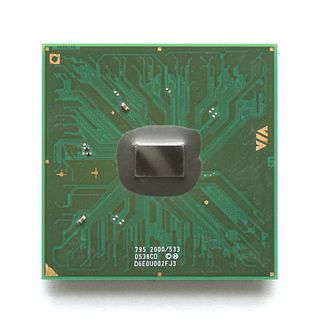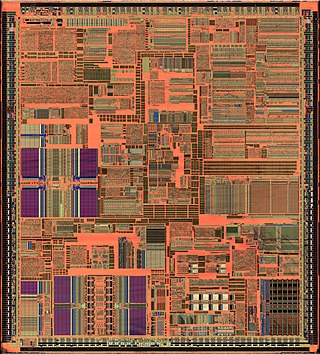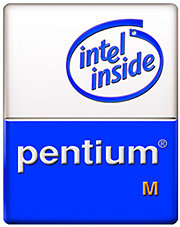
Celeron is a discontinued series of low-end IA-32 and x86-64 computer microprocessor models targeted at low-cost personal computers, manufactured by Intel. The first Celeron-branded CPU was introduced on April 15, 1998, and was based on the Pentium II.

Pentium 4 is a series of single-core CPUs for desktops, laptops and entry-level servers manufactured by Intel. The processors were shipped from November 20, 2000 until August 8, 2008. It was removed from the official price lists starting in 2010, being replaced by Pentium Dual-Core.

The Pentium III brand refers to Intel's 32-bit x86 desktop and mobile CPUs based on the sixth-generation P6 microarchitecture introduced on February 28, 1999. The brand's initial processors were very similar to the earlier Pentium II-branded processors. The most notable differences were the addition of the Streaming SIMD Extensions (SSE) instruction set, and the introduction of a controversial serial number embedded in the chip during manufacturing. The Pentium III is also a single-core processor.

The Athlon 64 is a ninth-generation, AMD64-architecture microprocessor produced by Advanced Micro Devices (AMD), released on September 23, 2003. It is the third processor to bear the name Athlon, and the immediate successor to the Athlon XP. The Athlon 64 was the second processor to implement the AMD64 architecture and the first 64-bit processor targeted at the average consumer. Variants of the Athlon 64 have been produced for Socket 754, Socket 939, Socket 940, and Socket AM2. It was AMD's primary consumer CPU, and primarily competed with Intel's Pentium 4, especially the Prescott and Cedar Mill core revisions.
Tejas was a code name for Intel's microprocessor, which was to be a successor to the latest Pentium 4 with the Prescott core and was sometimes referred to as Pentium V. Jayhawk was a code name for its Xeon counterpart. The cancellation of the processors in May 2004 underscored Intel's historical transition of its focus on single-core processors to multi-core processors.

Xeon is a brand of x86 microprocessors designed, manufactured, and marketed by Intel, targeted at the non-consumer workstation, server, and embedded markets. It was introduced in June 1998. Xeon processors are based on the same architecture as regular desktop-grade CPUs, but have advanced features such as support for error correction code (ECC) memory, higher core counts, more PCI Express lanes, support for larger amounts of RAM, larger cache memory and extra provision for enterprise-grade reliability, availability and serviceability (RAS) features responsible for handling hardware exceptions through the Machine Check Architecture (MCA). They are often capable of safely continuing execution where a normal processor cannot due to these extra RAS features, depending on the type and severity of the machine-check exception (MCE). Some also support multi-socket systems with two, four, or eight sockets through use of the Ultra Path Interconnect (UPI) bus, which replaced the older QuickPath Interconnect (QPI) bus.
The NetBurst microarchitecture, called P68 inside Intel, was the successor to the P6 microarchitecture in the x86 family of central processing units (CPUs) made by Intel. The first CPU to use this architecture was the Willamette-core Pentium 4, released on November 20, 2000 and the first of the Pentium 4 CPUs; all subsequent Pentium 4 and Pentium D variants have also been based on NetBurst. In mid-2001, Intel released the Foster core, which was also based on NetBurst, thus switching the Xeon CPUs to the new architecture as well. Pentium 4-based Celeron CPUs also use the NetBurst architecture.

The VIA C7 is an x86 central processing unit designed by Centaur Technology and sold by VIA Technologies.

The P6 microarchitecture is the sixth-generation Intel x86 microarchitecture, implemented by the Pentium Pro microprocessor that was introduced in November 1995. It is frequently referred to as i686. It was planned to be succeeded by the NetBurst microarchitecture used by the Pentium 4 in 2000, but was revived for the Pentium M line of microprocessors. The successor to the Pentium M variant of the P6 microarchitecture is the Core microarchitecture which in turn is also derived from P6.
The Intel Core microarchitecture is a multi-core processor microarchitecture launched by Intel in mid-2006. It is a major evolution over the Yonah, the previous iteration of the P6 microarchitecture series which started in 1995 with Pentium Pro. It also replaced the NetBurst microarchitecture, which suffered from high power consumption and heat intensity due to an inefficient pipeline designed for high clock rate. In early 2004 the new version of NetBurst (Prescott) needed very high power to reach the clocks it needed for competitive performance, making it unsuitable for the shift to dual/multi-core CPUs. On May 7, 2004 Intel confirmed the cancellation of the next NetBurst, Tejas and Jayhawk. Intel had been developing Merom, the 64-bit evolution of the Pentium M, since 2001, and decided to expand it to all market segments, replacing NetBurst in desktop computers and servers. It inherited from Pentium M the choice of a short and efficient pipeline, delivering superior performance despite not reaching the high clocks of NetBurst.

Yonah is the code name of Intel's first generation 65 nm process CPU cores, based on cores of the earlier Banias / Dothan Pentium M microarchitecture. Yonah CPU cores were used within Intel's Core Solo and Core Duo mobile microprocessor products. SIMD performance on Yonah improved through the addition of SSE3 instructions and improvements to SSE and SSE2 implementations; integer performance decreased slightly due to higher latency cache. Additionally, Yonah included support for the NX bit.

Pentium is a discontinued series of x86 architecture-compatible microprocessors produced by Intel. The original Pentium was first released on March 22, 1993. The name "Pentium" is originally derived from the Greek word pente (πεντε), meaning "five", a reference to the prior numeric naming convention of Intel's 80x86 processors (8086–80486), with the Latin ending -ium since the processor would otherwise have been named 80586 using that convention.

The Pentium Dual-Core brand was used for mainstream x86-architecture microprocessors from Intel from 2006 to 2009, when it was renamed to Pentium. The processors are based on either the 32-bit Yonah or 64-bit Merom-2M, Allendale, and Wolfdale-3M core, targeted at mobile or desktop computers.
AMD Turion is the brand name AMD applies to its x86-64 low-power consumption (mobile) processors codenamed K8L. The Turion 64 and Turion 64 X2/Ultra processors compete with Intel's mobile processors, initially the Pentium M and the Intel Core and Intel Core 2 processors.

Conroe is the code name for many Intel processors sold as Core 2 Duo, Xeon, Pentium Dual-Core and Celeron. It was the first desktop processor to be based on the Core microarchitecture, replacing the NetBurst microarchitecture based Cedar Mill processor. It has product code 80557, which is shared with Allendale and Conroe-L that are very similar but have a smaller L2 cache. Conroe-L has only one processor core and a new CPUID model. The mobile version of Conroe is Merom, the dual-socket server version is Woodcrest, the quad-core desktop version is Kentsfield and the quad-core dual-socket version is Clovertown. Conroe was replaced by the 45 nm Wolfdale processor.

Merom is the code name for various mobile Intel processors that are sold as Core 2 Duo, Core 2 Solo, Pentium Dual-Core and Celeron. It was the first mobile processor to be based on the Core microarchitecture, replacing the Enhanced Pentium M-based Yonah processor. Merom has the product code 80537, which is shared with Merom-2M and Merom-L that are very similar but have a smaller L2 cache. Merom-L has only one processor core and a different CPUID model. The desktop version of Merom is Conroe and the dual-socket server version is Woodcrest. Merom was manufactured in a 65 nanometer process, and was succeeded by Penryn, a 45 nm version of the Merom architecture. Together, Penryn and Merom represented the first 'tick-tock' in Intel's Tick-Tock manufacturing paradigm, in which Penryn was the 'tick' to Merom's 'tock'.

Penryn is the code name of a processor from Intel that is sold in varying configurations as Core 2 Solo, Core 2 Duo, Core 2 Quad, Pentium and Celeron.
The HP Pavilion dv1000 was a model series of "thin and light" widescreen laptops manufactured by Hewlett-Packard Company that features a 14.1" diagonal 16:10 display.
Bonnell is a CPU microarchitecture used by Intel Atom processors which can execute up to two instructions per cycle. Like many other x86 microprocessors, it translates x86 instructions into simpler internal operations prior to execution. The majority of instructions produce one micro-op when translated, with around 4% of instructions used in typical programs producing multiple micro-ops. The number of instructions that produce more than one micro-op is significantly fewer than the P6 and NetBurst microarchitectures. In the Bonnell microarchitecture, internal micro-ops can contain both a memory load and a memory store in connection with an ALU operation, thus being more similar to the x86 level and more powerful than the micro-ops used in previous designs. This enables relatively good performance with only two integer ALUs, and without any instruction reordering, speculative execution or register renaming. A side effect of having no speculative execution is invulnerability against Meltdown and Spectre.


















